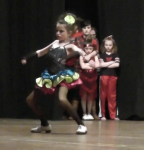Back before Google, some friends and I went to a dance event in Montreal for a week. I got a map of the city from AAA, and spent time studying the neighborhood where we would stay. Maps are fun—everything is right there. I enjoyed finding our hotel, the class venue, and getting to know the streets in and around our location.
This paid off, because when we were driving around trying to find things, I knew which way to go. I knew which street got us back to the hotel, where the metro was, etc. I knew my way around, though I had never been there. Even on unfamiliar streets, I had a good idea of where we would end up, because I knew the shape of the area.
Just like going to to a new town, it’s nice to study the map of a new song.
One difficulty students face with Oriental music is its unfamiliarity. Dancing a song is a lot easier when you have a map. Sadly, there is no AAA for Arabic music. Happily, music has a lot of consistent elements from song to song, so even if you don’t know a specific song, you can still find your way around.
What is structure? Most musical compositions have some level of internal structure, from simple to complex. There are multiple parts to the song. These are arranged so that the musicians know when each part is coming. Most Eastern bands do not use sheet music—they learn the song by heart, the better to play what they feel in the moment. The better an overall understanding of structure we have, the easier it is to dance on a new song.

How do we discover structure? One way is by listening to lots of music. You get it by osmosis. Listening will do well for a lot of the old nightclub style music (and some Arab pop), with a relatively simple structure. There are usually two themes, the verse (the same melody and different words), and the chorus (same melody and same words), some taqasim (instrumental solos), and maybe a bridge (a connector).
Most of these sections will be in phrases of 4 or 8 measures (one measure is usually one iteration of the rhythm). This is similar to Western blues, rock, and pop. As we get familiar with the material in general, it becomes fairly simple to anticipate when one section will end and new one begins—even when we don’t know the song.
Mapping helps with the more sophisticated orchestral music
For example, Om Kalthum, entrances, and other complex music written specifically for dance. Each piece has many themes, including surprising changes in rhythm, tempo, and melody. One simple way of mapping is to draw the music as it occurs—our drawings will show us the overall shape of the music. But we can also be quite deep with our notation.
Thanks to the miracle of recorded music, we can break these pieces down to their elements. Through listening over and over to a song, one can begin to discern the patterns—repeating melodies, sections of taqsim, rhythm changes etc. We can note these. Just watch the time on your player, and mark on paper every major change in the song. As you then notice the changing (and recurring) themes, you can label them—A, B, C, etc. Or you can ID them as verse, chorus, (or Khaligi part, Viking, whatever fanciful name helps you to recognize the section). Each rhythm change, taqsim, etc. can be noted as well (I use a spreadsheet).
You can get super exact, but often one section will have a couple of elements. If they repeat the same way most times, then together they are one theme. After noting, them, count how many measures each section is, and write that down, too. It’s always interesting, especially when some part of a song is giving you trouble. Doing all this will give you a map of the music, so you know your way around.
Plus, the musicians signal when to change.
They signal changes by slowing down, speeding up, playing short sections of the new rhythm before beginning the melody, etc. Over time, you get a handle on song structure and the messages of transition. Even new, complex songs become more manageable. Sure, there will be sections that throw, you, but most of it will make sense.
Knowing complex songs in advance is optimal. The musicians do—so should we. In 2004, I heard the song Darit il Ayyam for the very first time—while dancing on it. In the Ahlan wa Sahlan festival contest. With a live orchestra. Darit il Ayyam is a complicated Egyptian orchestral piece made famous by Om Kalthum. While I looked (most of the time) like I knew what I was doing, I was at sea for a lot of it. And that’s not always fun.
I didn’t have a map to that particular song. But like the grid structure in a city, you get a sense of where you are going and which turns will take you back to the main road. Still, it can be pretty hair-raising as you barrel around the turn, only to discover that the road stops suddenly and you are heading into the oncoming traffic. So for music like this, whenever possible, know your songs before you dance them. Understanding their structure gives us space to play with the music in a more relaxed way.
The musicians have practiced these songs.
They have learnt them by heart. That familiarity gives them the space to improvise within the structure. This approach works well for dancers, too. Plus, the lyrics are often poetry. Even when the song is played as an instrumental, it helps to understand the emotional themes of the song, over and above the feelings one gets from the music.
The great thing is that it can be done. And every song you analyze gives you insights to every other song.
Love,
Alia
PS How to Map Your Music, a new on-demand Teachable class, is coming–soon ; )
Music: Here’s a beautiful song by Simon Shaheen. What structure or patterns do you find? https://www.youtube.com/watch?v=wpAT94SGNtI






No comment yet, add your voice below!